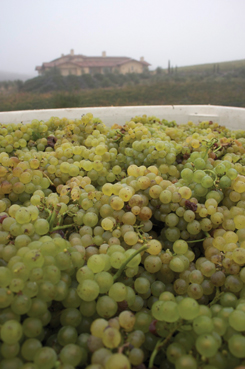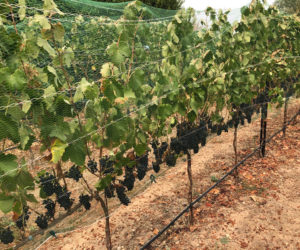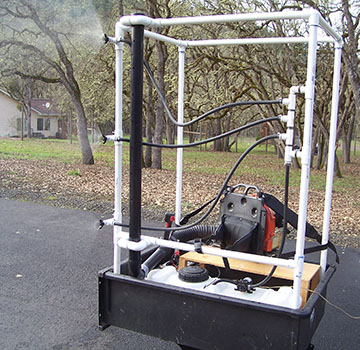 Chardonnay is a grape varietal that has an identity crisis. She is both a rock star and a charlatan, a soft spoken ballerina and a brazen harlot, generic as a white label with a blue stripe across it and as expressive as a zealot. Why is this varietal so likely to cause both passionate debate and bored indifference? I’m going to try to make the suggestion in the text of this short article on growing Chardonnay in your backyard, that it has to do with where its grown and how it is made.
Chardonnay is a grape varietal that has an identity crisis. She is both a rock star and a charlatan, a soft spoken ballerina and a brazen harlot, generic as a white label with a blue stripe across it and as expressive as a zealot. Why is this varietal so likely to cause both passionate debate and bored indifference? I’m going to try to make the suggestion in the text of this short article on growing Chardonnay in your backyard, that it has to do with where its grown and how it is made.
Americans were some of the last to plant Chardonnay, and some of the first to take it for granted. In the 1960s there was less than 1,000 acres planted in California, and most of it was mislabeled as “Chablis,” which of course is a region, not a varietal. So from the get go, Californians screwed it up, doing more damage to the noble wines of Chablis with our unfair mislabeling as any devious ad campaign could have. Innocuous, cheap, uninteresting, flat Chardonnays from California stole the name from Chablis — and Chablis is still used as a name for the generic white wines that come out of large grape production areas of the Central Valley of California. Shame, as the REAL Chablis produces some of the most beautiful, long lived and expressive white wines (100% Chardonnay, as always) in the world. There is currently about 100,000 acres of Chardonnay under cultivation in California, three times the amount that is bearing in Burgundy and Chablis, the homeland of Chardonnay, and arguably the world’s greatest terroir for producing white wine. (Notice I only use the term terroir when it applies to French wine regions with centuries of history and pedigree. We don’t have the history to use the term yet, in my never-to-be-humble opinion.)
Other regions (besides California, and specifically Sonoma Coast, Santa Cruz, Anderson Valley, Mendocino, Chalone, Monterey County, Santa Barbara County — and specifically the Santa Rita Hills) that have shown great promise with the Chardonnay grape include Margaret River, Australia, Oregon, Washington (especially in the Columbia River Gorge), New Zealand and New York. Of course as soon as I think I’ve tried wines from all the areas that can grow world-class Chardonnay, a wine arrives in my glass showing me just how generous a varietal it can be. Like Pinot Noir, I believe Chardonnay suffers no fools, but unlike Pinot Noir (a very distant relative of Chardonnay), Chardonnay can take a lot of manipulation by the winemaker. It’s a varietal, as a famous winemaker once told me, that “you can hang a lot of clothes on.”
That means that the treatment in the winery can dictate the wine’s final style almost as much as the appellation of the sourced fruit. Oak treatment is famous in Chardonnay production. During America’s undeniable love affair with oaky Chardonnay in the 1980s and 1990s (a trend I’m happy to say is dying slowly in most regions), some producers (even in France!) bragged that they were using 200% new French oak in their Chardonnays. That means the wine would be fermented and aged six months in a brand new barrel, and then racked into another brand new French oak barrel. While some would call this a “luxury cuvee,” putting almost $10 of new oak in every bottle of Chardonnay is like drenching a beautiful prime ribeye in A1 sauce. It may taste good to some, but to most of us it seems a waste of quality base product, and will surely obliterate the uniqueness of flavor either in a well-bred Angus steer or some nice coastal Chardonnay fruit. Malolactic fermentation (which is not a true fermentation but more accurately a bacterial process of decarboxylating malic acid into lactic acid by Leuconostoc oenos) is another process by which Chardonnay can be stylized, and the buttery style (as distinct or combined with oak treatment) still has many fans in the white wine world. It can be argued that the combination of malolactic treatment and oakiness made Chardonnay in the 1980s and 1990s so recognizable, that Chardonnay, as Jancis Robinson once famously quipped, “Virtually became its own brand.” It became synonymous with white wine.
So now that the tide is turning stylistically in Chardonnay, what is the varietal today and what direction is it moving? Of the hundreds of Chardonnays I taste judging international wine competitions each year, few remain the big, buttery monsters of the late twentieth century. Chardonnay is losing weight in the new Millennia, becoming more yoga and less elephant, more like a crisp green apple rolling on earthy river pebbles than caramel and butter popcorn absorbing the aromas of a French lumbermill. As a true believer in the varietal, I couldn’t be more pleased. Chardonnay has a flavor of its own — one of the few wine varietals that screams place and represents the vineyard where it was grown, and seeing the wines become more transparent to the pedigree is always a step in the right direction from my perspective.
So now that we’re through looking at Chardonnay from a historic perspective, let’s discuss why and how you may want to delve into the process of planting some in your backyard.
If you read this column regularly, it won’t surprise you at all when the next paragraph suggest that you look at other grape varietal choices before choosing Chardonnay. It is far more important to grow the right varietal match for your locale than to grow some insipid wine you can call Chardonnay. I was serious when I said Chardonnay suffers no fools. Grown in the wrong climate, the wine can be
truly disappointing.
Chardonnay likes a cool climate. If you want to grow grapes in a hot, inland climate I can almost guarantee you that Chardonnay will be a let down. The acid respires too quickly in an inland or continental climate, and the wine becomes soft, flat and less than uninteresting. If you know how many degree days or what Winkler zone you live in, that will be very helpful in choosing a good match. (The Winkler scale is a technique developed at UC-Davis for classifying the climates of wine growing regions.) If you don’t know your soil type, degree day accumulation, water quality and have a solid plan for the vineyard, you are nowhere near ready to install a vineyard.
Chardonnay should be planted in a Region 1 (<2,500 degree days) growing area, and rarely in a Region 2 (2,500-3,000). Any hotter than that, cool climate varietals like Chardonnay lose all varietal character and structure and you’d be better off giving up viticulture and just buying wine that tastes good.
But let’s assume for now that you live in an area where Chardonnay can grow in balance, hang a good long time and make fine wine. Or you skipped to this part in the article because you don’t like being told what you can and can’t do. You’re the boss, and you want to grow some Chardonnay!
Important tips for planning and installing a Chardonnay vineyard:
(For general tips on planting a home vineyard, check out my previous articles on the subject, or order some of my lectures from the WineMaker Conferences at www.winemakermag.com/store.)
1: Plant on a hillside with a place for the frost to drain. Many areas that are prime for Chardonnay production are also prone to spring frosts. If you can put the vineyard on a higher elevation with a spot for the cold air to drain, you will save yourself a lot of hassles.
2: Measure your backyard vineyard space and figure out your planting density. I usually recommend at least 6 feet (1.8 m) between rows and 3 to 4 feet (~ 1 m) between vines for home vineyards. Remember the one-to-one rule: you need as much room in between vine rows as the height of the fully mature canopy. So most canopies reach about 6 feet (1.8 m), and if you anticipate higher vigor you may want to increase the rows to 8 feet apart. If the rows are too tight, rows will shade interior rows and you won’t get proper sun penetration into the canopy. This principle is vital to Chardonnay, as shaded fruit can develop an olive or canned veggie character, which will thus affect the wine.
3: Try the new clones, or go to an older age. My suggestions for ordering your vines are the following cultivars of Chardonnay: 76, 96 (newer Dijon clones) or Wente (more of an older California selection, but may be harder to find). I find these make the best Chardonnays again and again in the proper locations. They won’t turn Kansas into Santa Barbara, but they can make very nice wines if put in the right soil and climate.
4: Use vertical shoot positioning-style trellising. A trellis system that uses sets of catch wires to direct all growth vertically (up) is a good way to grow fruit that is properly exposed to sun and causes the wind to blow through the fruit zone to keep mildew and rot pressure down. It also enables very tidy leaf and shoot removal and creates a “curtain” of neat foliage that works like a solar panel, especially if you can plant your rows in a North/South orientation in the way that I normally recommend.
5: Small vineyard = good when it comes to weed control. There’s some fabulous methods available to the home vineyardists for weed control that would be too difficult or expensive at a commercial vineyard. Putting 2–3 feet (60–90 cm) of weed cloth down under the vine row and then covering it with mulch, pebbles or larger rocks will do wonders to keeping the vine rows clear of competing weeds, and will also make your watering/water holding capacity improved. You can also easily clear weeds from the vine row in just a few hours with a hoe. There’s nothing wrong with using a little Roundup® in dormancy (NEVER use while the vine has green growth), but why rely on chemicals when it is so easy to keep a small vineyard
tidy organically.
6: The biggie: mildew! Powdery mildew really loves Chardonnay. It seems as susceptible to mildew as any varietal I’ve ever worked with, and in those cool, foggy, coastal throats where it makes the best wine the mildew hits hardest. Make sure to start spraying wettable sulfur at about 4 inches (10 cm) average shoot growth after budbreak, and spray every seven to ten days for the first few years to get mildew under control. After bunch closure you may want to move to stylet oil, and spray on a seven-day interval. After a few years of mildew-free farming, you can add a day to the interval as long as all the fruit and vines stay clean. You may find a fourteen-day interval works just fine, but you don’t want to start there and lose a crop. Botrytis also likes Chardonnay, so you may want to add some copper sulfate to your first few sulfur sprays, which will slow down early season Botrytis and also help a bit with frost protection. Ten percent (or less) of Botrytis spores on fruit going into the crusher is not a big deal. If there’s more than that you may want to switch gears — think about letting it hang and get covered and make some dessert wine. A kiss of Botrytis in Chardonnay adds a lovely honeyed, nutty character, even in a dry wine.
7: Don’t rush the young vines to produce. Chardonnay, like all grapevines, needs to develop a strong root system to be able to ripen a crop, pull up water and nutrients. I suggest cutting the vines back to two buds after their first year in the ground so that the first year is all about root growth, the second year is about developing the trunk, and then the first crop comes off in either the third or fourth year depending on vigor.
8: Canopy management. Chardonnay can really be improved by proper canopy management. Here’s a step-by-step breakdown for what we do to grow Chardonnay at Clos Pepe:
• First pass: (Two to three weeks after budbreak.) Knock off all the suckers and growth from areas not emanating from last year’s (retained) wood. Rub the trunks to get the little water buds off that will become suckers later in the season. Repeat this sucker/basal shoot removal with each subsequent pass through the vineyard.
• Second pass: Shoot thinning and lateral removal. This process is best done a month or so after budbreak. Remove the smaller of the two shoots if there is a double shoot growing from a single bud retained at pruning. Also pinch off the lateral shoots, especially around the fruiting zone. Also, clean out the head of the vine from any extra growth or non-fruitful shoots. Getting these areas tidy and thinned will open up the canopy, get the vine in balance and make leaf removal very swift and simple.
• Third pass: Leaf thinning. Done after flowering but before bunch closure. Remove enough leaves on the east side (morning side) to allow sun flecking and wind movement, but not enough to expose the clusters to the potential of sunburn. Learning the difference will take many years of practice and experimentation. Start at 20% leaf removal and leave leaves over the clusters to shelter them from the hottest sun from 10 am to 2 pm. Continue adding another 10% of leaf removal from the fruiting zone each year until you see some sunburn develop, then back off a bit the next year. Getting at least 10–15% of ambient sunlight inside the canopy and flecking the fruit is vital to improving the flavor of the fruit and promoting golden color and richness in the resulting wine.
• Fourth pass: Fine tuning. The last pass before bird netting should fine tune the vines to be consistent. You may have to drop a few clusters if there’s too much crop or the clusters are nesting together. Give each cluster its own niche space in the canopy. You may have to pull a few more laterals or leaves if the canopy regrew after the first pass. Making each vine consistent in its ratio of leaves to clusters (12–15:1) is vital in the fine tuning pass. This pass can also include hedging the vine if the growth is getting too high and rank.
• Fifth pass: Netting. Bird netting is really worth it, especially in a small backyard vineyard. I recommend black plastic netting at a 14-foot (4.3-m) width, and definitely gather the bottoms up, roll them together, and secure with a twist-tie to make sure birds or squirrels can’t get into the nets from the bottom. Taking those nets off on harvest morning and seeing undisturbed, unpecked berries is worth all the hard, dusty work of netting. Nets should last at least five seasons if properly handled and stored.
• Sixth pass: Harvest! You know how to do that!
That’s all the general information I have to share on the growing and tending of Chardonnay vines. As long as you have the rare, cool climate and moderate to low-vigor soil, Chardonnay can produce wines that have an amazing combination of up-front richness and bracing acidity and mineral character in the finish.
Chardonnay is not a grape for every occasion, but when it finds a good home, it will repay your work with sound fruit and delicious wine. Keep your spray schedules, get your canopy management done in the right growth period of the vines and your Chardonnay vineyard should keep you in delicious white wine for generations to come.
Wes Hagen writes “Backyard Vines” in every issue of WineMaker.







